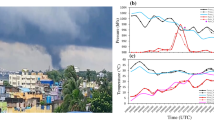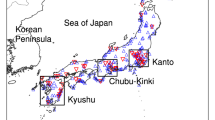Abstract
Devastating tornadoes in China have received growing attention in recent years, but little is known about their formation, structure, and evolution on the tornadic scale. Most of these tornadoes develop within the East Asian monsoon regime, in an environment quite different from tornadoes in the U.S. In this study, we used an idealized, highresolution (25-m grid spacing) numerical simulation to investigate the deadly EF4 (Enhanced Fujita scale category 4) tornado that occurred on 23 June 2016 and claimed 99 lives in Yancheng, Jiangsu Province. A tornadic supercell developed in the simulation that had striking similarities to radar observations. The violent tornado in Funing County was reproduced, exceeding EF4 (74 m s–1), consistent with the on-site damage survey. It was accompanied by a funnel cloud that extended to the surface, and exhibited a double-helix vorticity structure. The signal of tornado genesis was found first at the cloud base in the pressure perturbation field, and then developed both upward and downward in terms of maximum vertical velocity overlapping with the intense vertical vorticity centers. The tornado’s demise was found to accompany strong downdrafts overlapping with the intense vorticity centers. One of the interesting findings of this work is that a violent surface vortex was able to be generated and maintained, even though the simulation employed a free-slip lower boundary condition. The success of this simulation, despite using an idealized numerical approach, provides a means to investigate more historical tornadoes in China.
Similar content being viewed by others
References
Atkins, N. T., K. M. Butler, K. R. Flynn, et al., 2014: An integrated damage, visual, and radar analysis of the 2013 Moore, Oklahoma, EF5 tornado. Bull. Amer. Meteor. Soc., 95, 1549–1561, doi: 10.1175/BAMS-D-14-00033.1.
Bai, L. Q., Z. Y. Meng, L. Huang, et al., 2017: Integrated damage, visual, and radar analysis of the 2015 Foshan, Guangdong, EF3 Tornado in China produced by the landfalling Typhoon Mujigae (2015). Bull. Amer. Meteor. Soc., 98, 2619–2640, doi: 10.1175/BAMS-D-16-0015.1.
Bodine, D. J., T. Maruyama, R. D. Palmer, et al., 2016: Sensitivity of tornado dynamics to soil debris loading. J. Atmos. Sci., 73, 2783–2801, doi: 10.1175/JAS-D-15-0188.1.
Bryan, G. H., and J. M. Fritsch, 2002: A benchmark simulation for moist nonhydrostatic numerical models. Mon. Wea. Rev., 130, 2917–2928, doi: 10.1175/1520-0493(2002)130<2917:ABSFMN>2.0.CO;2.
Clark, A. J., J. S. Kain, P. T. Marsh, et al., 2012: Forecasting tornado pathlengths using a three-dimensional object identification algorithm applied to convection-allowing forecasts. Wea. Forecasting, 27, 1090–1113, doi: 10.1175/WAF-D-11-00147.1.
Clark, A. J., J. D. Gao, P. T. Marsh, et al., 2013: Tornado pathlength forecasts from 2010 to 2011 using ensemble updraft helicity. Wea. Forecasting, 28, 387–407, doi: 10.1175/WAFD-12-00038.1.
Coffer, B. E., and M. D. Parker, 2017: Simulated supercells in nontornadic and tornadic VORTEX2 environments. Mon. Wea. Rev., 145, 149–180, doi: 10.1175/MWR-D-16-0226.1.
Davies-Jones, R., 2015: A review of supercell and tornado dynamics. Atmos. Res., 158–159, 274–291, doi: 10.1016/j.atmosres.2014.04.007.
Davies-Jones, R., and P. Markowski, 2013: Lifting of ambient air by density currents in sheared environments. J. Atmos. Sci., 70, 1204–1215, doi: 10.1175/JAS-D-12-0149.1.
Ek, M. B., K. E. Mitchell, Y. Lin, et al., 2003: Implementation of Noah land surface model advances in the National Centers for Environmental Prediction operational mesoscale Eta model. J. Geophys. Res., 108, 8851, doi: 10.1029/2002JD003296.
French, M. M., H. B. Bluestein, I. PopStefanija, et al., 2013: Reexamining the vertical development of tornadic vortex signatures in supercells. Mon. Wea. Rev., 141, 4576–4601, doi: 10.1175/MWR-D-12-00315.1.
Grasso, L. D., and W. R. Cotton, 1995: Numerical simulation of a tornado vortex. J. Atmos. Sci., 52, 1192–1203, doi: 10.1175/1520-0469(1995)052<1192:NSOATV>2.0.CO;2.
Hong, S.-Y., and H.-L. Pan, 1996: Nonlocal boundary layer vertical diffusion in a medium-range forecast model. Mon. Wea. Rev., 124, 2322–2339, doi: 10.1175/1520-0493(1996)124<2322:NBLVDI>2.0.CO;2.
Houser, J. L., H. B. Bluestein, and J. C. Snyder, 2016: A finescale radar examination of the tornadic debris signature and weakecho reflectivity band associated with a large, violent tornado. Mon. Wea. Rev., 144, 4101–4130, doi: 10.1175/MWR-D-15-0408.1.
Iacono, M. J., J. S. Delamere, E. J. Mlawer, et al., 2008: Radiative forcing by long-lived greenhouse gases: Calculations with the AER radiative transfer models. J. Geophys. Res., 113, D13103, doi: 10.1029/2008JD009944.
Kain, J. S., 2004: The Kain Fritsch convective parameterization: An update. J. Appl. Meteor., 43, 170–181, doi: 10.1175/1520-0450(2004)043<0170:TKCPAU>2.0.CO;2.
Kain, J. S., S. J. Weiss, D. R. Bright, et al., 2008: Some practical considerations regarding horizontal resolution in the first generation of operational convection-allowing NWP. Wea. Forecasting, 23, 931–952, doi: 10.1175/WAF2007106.1.
Klemp, J. B., and R. B. Wilhelmson, 1978: Simulations of right- and left-moving storms produced through storm splitting. J. Atmos. Sci., 35, 1097–1110, doi: 10.1175/1520-0469(1978)035<1097:SORALM>2.0.CO;2.
Klemp, J. B., R. B. Wilhelmson, and P. S. Ray, 1981: Observed and numerically simulated structure of a mature supercell thunderstorm. J. Atmos. Sci., 38, 1558–1580, doi: 10.1175/1520-0469(1981)038<1558:OANSSO>2.0.CO;2.
Lim, K. S. S., and S. Y. Hong, 2010: Development of an effective double-moment cloud microphysics scheme with prognostic cloud condensation nuclei (CCN) for weather and climate models. Mon. Wea. Rev., 138, 1587–1612, doi: 10.1175/2009MWR2968.1.
Markowski, P. M., 2016: An idealized numerical simulation investigation of the effects of surface drag on the development of near-surface vertical vorticity in supercell thunderstorms. J. Atmos. Sci., 73, 4349–4385, doi: 10.1175/JAS-D-16-0150.1.
Markowski, P. M., and Y. P. Richardson, 2009: Tornadogenesis: Our current understanding, forecasting considerations, and questions to guide future research. Atmos. Res., 93, 3–10, doi: 10.1016/j.atmosres.2008.09.015.
Markowski, P. M., and G. H. Bryan, 2016: LES of laminar flow in the PBL: A potential problem for convective storm simulations. Mon. Wea. Rev., 144, 1841–1850, doi: 10.1175/MWRD-15-0439.1.
Markowski, P. M., and Y. P. Richardson, 2017: Large sensitivity of near-surface vertical vorticity development to heat sink location in idealized simulations of supercell-like storms. J. Atmos. Sci., 74, 1095–1104, doi: 10.1175/JAS-D-16-0372.1.
Markowski, P., Y. Richardson, and G. Bryan, 2014: The origins of vortex sheets in a simulated supercell thunderstorm. Mon. Wea. Rev., 142, 3944–3954, doi: 10.1175/MWR-D-14-00162.1.
Meng, Z. Y., and D. Yao, 2014: Damage survey, radar, and environment analyses on the first-ever documented tornado in Beijing during the heavy rainfall event of 21 July 2012. Wea. Forecasting, 29, 702–724, doi: 10.1175/WAF-D-13-00052.1.
Meng, Z. Y., D. Yao, L. Q. Bai, et al., 2016: Wind estimation around the shipwreck of Oriental Star based on field damage surveys and radar observations. Sci. Bull., 61, 330–337, doi: 10.1007/s11434-016-1005-2.
Naylor, J., and M. S. Gilmore, 2014: Vorticity evolution leading to tornadogenesis and tornadogenesis failure in simulated supercells. J. Atmos. Sci., 71, 1201–1217, doi: 10.1175/JAS-D-13-0219.1.
Naylor, J., M. A. Askelson, and M. S. Gilmore, 2012: Influence of low-level thermodynamic structure on the downdraft properties of simulated supercells. Mon. Wea. Rev., 140, 2575–2589, doi: 10.1175/MWR-D-11-00200.1.
Nowotarski, C. J., P. M. Markowski, Y. P. Richardson, et al., 2014: Properties of a simulated convective boundary layer in an idealized supercell thunderstorm environment. Mon. Wea. Rev., 142, 3955–3976, doi: 10.1175/MWR-D-13-00349.1.
Orf, L., R. Wilhelmson, B. Lee, et al., 2017: Evolution of a longtrack violent tornado within a simulated supercell. Bull. Amer. Meteor. Soc., 98, 45–68, doi: 10.1175/BAMS-D-15-00073.1.
Rasmussen, E. N., 2003: Refined supercell and tornado forecast parameters. Wea. Forecasting, 18, 530–535, doi: 10.1175/1520-0434(2003)18<530:RSATFP>2.0.CO;2.
Rasmussen, E. N., and D. O. Blanchard, 1998: A baseline climatology of sounding-derived supercell and tornado forecast parameters. Wea. Forecasting, 13, 1148–1164, doi: 10.1175/1520-0434(1998)013<1148:ABCOSD>2.0.CO;2.
Roberts, B., M. Xue, A. D. Schenkman, et al., 2016: The role of surface drag in tornadogenesis within an idealized supercell simulation. J. Atmos. Sci., 73, 3371–3395, doi: 10.1175/JASD-15-0332.1.
Rotunno, R., 2013: The fluid dynamics of tornadoes. Annu. Rev. Fluid Mech., 45, 59–84, doi: 10.1146/annurev-fluid-011212-140639.
Rotunno, R., P. M. Markowski, and G. H. Bryan, 2017: “Near ground” vertical vorticity in supercell thunderstorm models. J. Atmos. Sci., 74, 1757–1766, doi: 10.1175/JAS-D-16-0288.1.
Schenkman, A. D., M. Xue, and M. Hu, 2014: Tornadogenesis in a high-resolution simulation of the 8 May 2003 Oklahoma City supercell. J. Atmos. Sci., 71, 130–154, doi: 10.1175/JAS-D-13-073.1.
Stensrud, D. J., L. J. Wicker, M. Xue, et al., 2013: Progress and challenges with Warn-on-Forecast. Atmos. Res., 123, 2–16, doi: 10.1016/j.atmosres.2012.04.004.
Sun, J. Z., M. Xue, J. W. Wilson, et al., 2014: Use of NWP for nowcasting convective precipitation: Recent progress and challenges. Bull. Amer. Meteor. Soc., 95, 409–426, doi: 10.1175/BAMS-D-11-00263.1.
Weisman, M. L., and R. Rotunno, 2000: The use of vertical wind shear versus helicity in interpreting supercell dynamics. J. Atmos. Sci., 57, 1452–1472, doi: 10.1175/1520-0469(2000)057<1452:TUOVWS>2.0.CO;2.
Wicker, L. J., and R. B. Wilhelmson, 1995: Simulation and analysis of tornado development and decay within a three-dimensional supercell thunderstorm. J. Atmos. Sci., 52, 2675–2703, doi: 10.1175/1520-0469(1995)0522<2675:SAAOTD>2.0.CO;2.
Wurman, J., D. Dowell, Y. Richardson, et al., 2012: The second verification of the origins of rotation in tornadoes experiment: VORTEX2. Bull. Amer. Meteor. Soc., 93, 1147–1170, doi: 10.1175/BAMS-D-11-00010.1.
Wurman, J., K. Kosiba, and P. Robinson, 2013: In situ, Doppler radar, and video observations of the interior structure of a tornado and the wind-damage relationship. Bull. Amer. Meteor. Soc., 94, 835–846, doi: 10.1175/BAMS-D-12-00114.1.
Xue, M., M. Hu, and A. D. Schenkman, 2014: Numerical prediction of the 8 May 2003 Oklahoma City tornadic supercell and embedded tornado using ARPS with the assimilation of WSR-88D Data. Wea. Forecasting, 29, 39–62, doi: 10.1175/WAF-D-13-00029.1.
Xue, M., K. Zhao, M. J. Wang, et al., 2016: Recent significant tornadoes in China. Adv. Atmos. Sci., 33, 1209–1217, doi: 10.1007/s00376-016-6005-2.
Yao, Y. Q., X. D. Yu, Y. J. Zhang, et al., 2015: Climate analysis of tornadoes in China. J. Meteor. Res., 29, 359–369, doi: 10.1007/s13351-015-4983-0.
Zhao, K., M. J. Wang, M. Xue, et al., 2017: Doppler radar analysis of a tornadic miniature supercell during the landfall of Typhoon Mujigae (2015) in South China. Bull. Amer. Meteor. Soc., 98, 1821–1831, doi: 10.1175/BAMS-D-15-00301.1.
Acknowledgments
The authors thank Prof. Yuqing Wang from the University of Hawaii, Prof. Dalin Zhang from the University of Maryland, and Prof. Yali Luo from the Chinese Academy of Meteorological Sciences (CAMS), for their instructive suggestions in revising this manuscript. We are also appreciative of the assistance of Drs. Hongli Wang and Ying Liu from CAMS, and Dr. Lin Zhang from the Meteorological Observation Center of China. Dr. Dan Yao is especially grateful to his Ph.D. degree supervisor, Prof. Zhiyong Meng from Peking University, who guided him onto the road of tornado damage survey and numerical simulation research. The editor and two anonymous reviewers are sincerely thanked for their instructive comments.
Author information
Authors and Affiliations
Corresponding author
Additional information
Supported by the National Natural Science Foundation of China (41705028, 41405095, and 41405006) and Basic Research Fund of the Chinese Academy of Meteorological Sciences [2017Y018, 2015Z003, and 2017Z017 (2017LASW-A02)].
Rights and permissions
About this article
Cite this article
Yao, D., Xue, H., Yin, J. et al. Investigation into the Formation, Structure, and Evolution of an EF4 Tornado in East China Using a High-Resolution Numerical Simulation. J Meteorol Res 32, 157–171 (2018). https://doi.org/10.1007/s13351-018-7083-0
Received:
Accepted:
Published:
Issue Date:
DOI: https://doi.org/10.1007/s13351-018-7083-0




